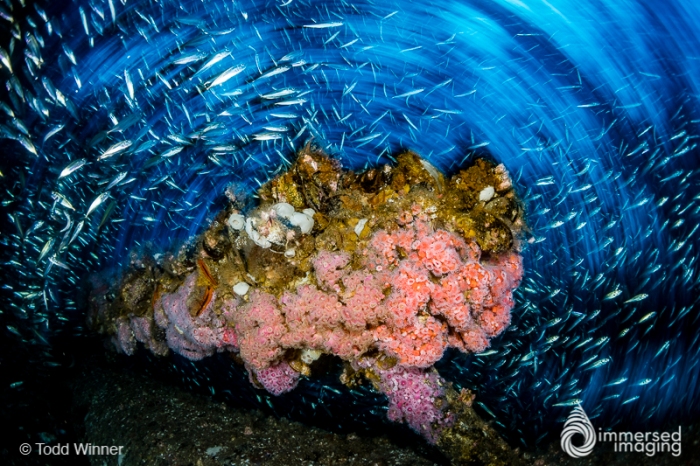
Oil rig and bait fish, Canon 5DS R, EF 8-15mm Fisheye, 1/15, f/7.1, ISO 320
The spin shot is one of the easier motion shots to pull off because you create the movement by spinning the camera and not relying on the subject to move though your frame to show motion. It works well with static subjects but I have also used it on sharks and other moving subjects. Shots like this tend to do quite well in shoot out style photo contests, especially if only minimal editing is allowed. I wouldn’t want it to be the only shot I entered but it’s a great addition after you’ve nailed the traditional macro and wide angle shots.

Crinoids on jetty, Canon 7D, EF 8-15mm Fisheye, 1/13, f/18, ISO 100
The shot is essentially a slow shutter ambient lit image with a strobe lit foreground. Because the strobe fires on and off in such a quick burst, any part of the subject lit by the strobe will be sharp just like it was shot with a fast shutter speed. The remaining ambient exposer continues to capture the movement of the camera until the rear curtain closes.
Start by finding a subject you think would look good with a swirl around it. Obviously there needs to be enough ambient light on the background. Crank down your strobe arms. If they are loose they will flop all over the place. I also keep them pretty close to the housing for these kind of images. Slow your shutter down, I like to start with 1/15 and adjust up or down from there. We are going to be letting in a lot of light with that slow shutter so use a low ISO like 100 or 200. For the aperture, you will need to stop down so you don’t let in too much light. I would probably start around f/11 – f/16 and adjust depending on the subject. With the small aperture you will need a fair amount of light. I like using manual strobes and starting at around 3/4 power. You can take test shots without moving the camera to dial in the exposer. First curtain or second curtain sync work for these shots but I think it’s easier to time the flash going off with the first curtain. I find it best to pre-focus on the subject and lock off the focus. You can use focus lock, switch the lens to manual or use back button focus, just don’t change the distance from the subject after you focus.

Batfish, Canon 7D, EF 8-15mm Fisheye, 1/15, f/18, ISO 100
Now it’s time for the spin! Decide if this is going to be a vertical or horizontal image. You can spin clockwise or counter clockwise, whatever is more comfortable for you. For a horizontal clockwise spinning image, start with your right hand at about the 1:00 position and in one fluid motion, spin the camera to the right, press the shutter when your right hand gets to the 3:00 position and continue until your right hand ends up at around the 7:00 position. Just make sure this all happens with one fluid motion. For a vertical clockwise spinning image, start with your right hand at about the 10:00 position and in one fluid motion, spin the camera to the right, press the shutter when your right hand gets to the 12:00 position and continue until your right hand ends up at around the 7:00 position. Expect a lot of missed shots before you get a keeper.

Mangrove, Canon 7D, EF 8-15mm Fisheye, 1/13, f/22, ISO 100
To finish off your image, intensify the look of the spin in post by increasing clarity and or the dehaze filter in Adobe Lightroom.









